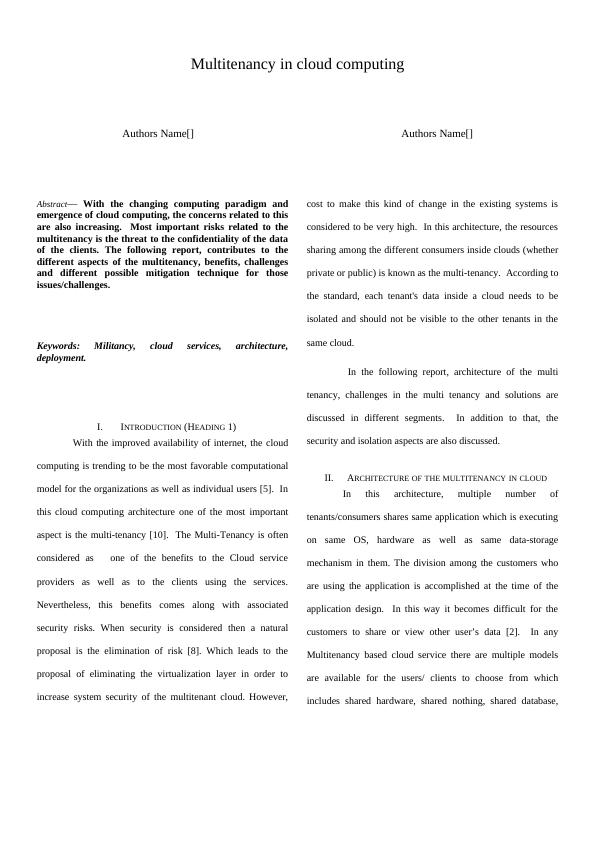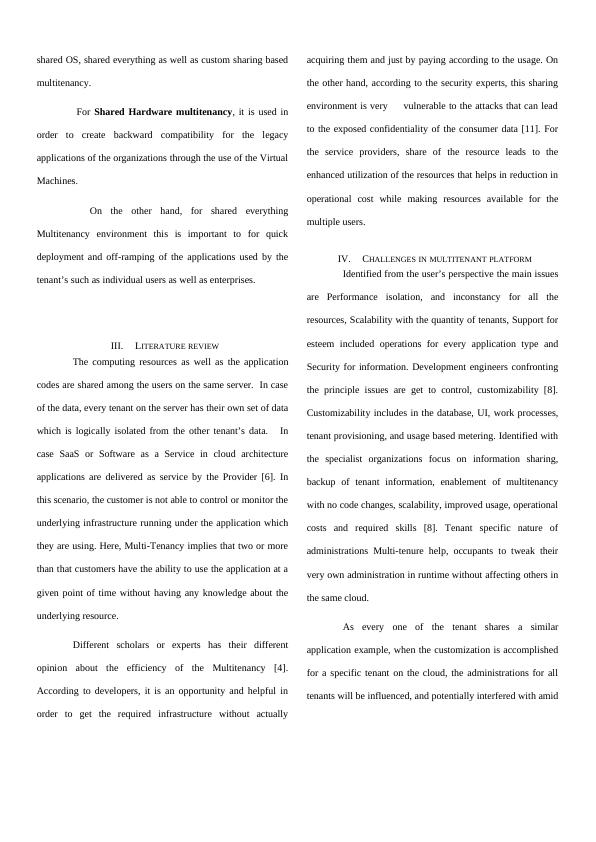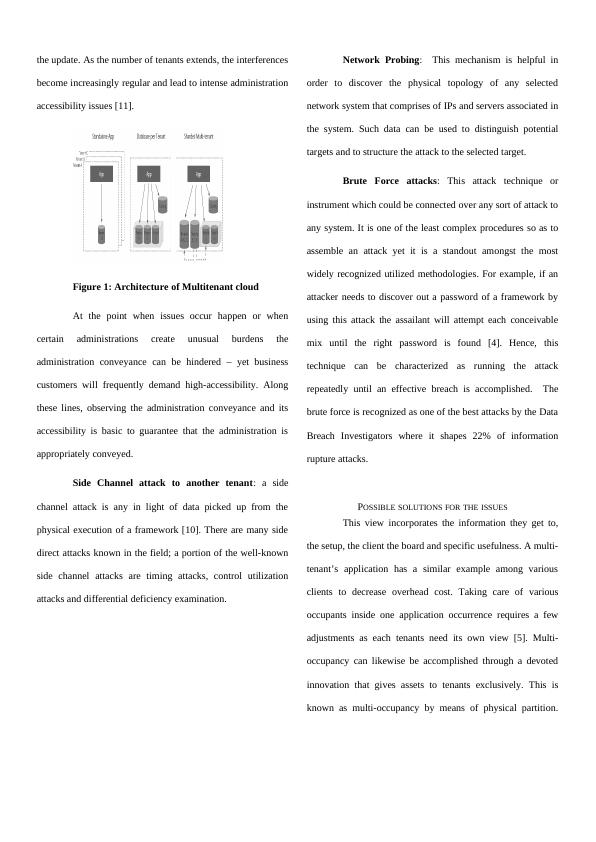Multitenancy in Cloud Computing
Added on 2023-03-17
6 Pages2861 Words29 Views
Multitenancy in cloud computing
Authors Name[] Authors Name[]
Abstract— With the changing computing paradigm and
emergence of cloud computing, the concerns related to this
are also increasing. Most important risks related to the
multitenancy is the threat to the confidentiality of the data
of the clients. The following report, contributes to the
different aspects of the multitenancy, benefits, challenges
and different possible mitigation technique for those
issues/challenges.
Keywords: Militancy, cloud services, architecture,
deployment.
I. INTRODUCTION (HEADING 1)
With the improved availability of internet, the cloud
computing is trending to be the most favorable computational
model for the organizations as well as individual users [5]. In
this cloud computing architecture one of the most important
aspect is the multi-tenancy [10]. The Multi-Tenancy is often
considered as one of the benefits to the Cloud service
providers as well as to the clients using the services.
Nevertheless, this benefits comes along with associated
security risks. When security is considered then a natural
proposal is the elimination of risk [8]. Which leads to the
proposal of eliminating the virtualization layer in order to
increase system security of the multitenant cloud. However,
cost to make this kind of change in the existing systems is
considered to be very high. In this architecture, the resources
sharing among the different consumers inside clouds (whether
private or public) is known as the multi-tenancy. According to
the standard, each tenant's data inside a cloud needs to be
isolated and should not be visible to the other tenants in the
same cloud.
In the following report, architecture of the multi
tenancy, challenges in the multi tenancy and solutions are
discussed in different segments. In addition to that, the
security and isolation aspects are also discussed.
II. ARCHITECTURE OF THE MULTITENANCY IN CLOUD
In this architecture, multiple number of
tenants/consumers shares same application which is executing
on same OS, hardware as well as same data-storage
mechanism in them. The division among the customers who
are using the application is accomplished at the time of the
application design. In this way it becomes difficult for the
customers to share or view other user’s data [2]. In any
Multitenancy based cloud service there are multiple models
are available for the users/ clients to choose from which
includes shared hardware, shared nothing, shared database,
Authors Name[] Authors Name[]
Abstract— With the changing computing paradigm and
emergence of cloud computing, the concerns related to this
are also increasing. Most important risks related to the
multitenancy is the threat to the confidentiality of the data
of the clients. The following report, contributes to the
different aspects of the multitenancy, benefits, challenges
and different possible mitigation technique for those
issues/challenges.
Keywords: Militancy, cloud services, architecture,
deployment.
I. INTRODUCTION (HEADING 1)
With the improved availability of internet, the cloud
computing is trending to be the most favorable computational
model for the organizations as well as individual users [5]. In
this cloud computing architecture one of the most important
aspect is the multi-tenancy [10]. The Multi-Tenancy is often
considered as one of the benefits to the Cloud service
providers as well as to the clients using the services.
Nevertheless, this benefits comes along with associated
security risks. When security is considered then a natural
proposal is the elimination of risk [8]. Which leads to the
proposal of eliminating the virtualization layer in order to
increase system security of the multitenant cloud. However,
cost to make this kind of change in the existing systems is
considered to be very high. In this architecture, the resources
sharing among the different consumers inside clouds (whether
private or public) is known as the multi-tenancy. According to
the standard, each tenant's data inside a cloud needs to be
isolated and should not be visible to the other tenants in the
same cloud.
In the following report, architecture of the multi
tenancy, challenges in the multi tenancy and solutions are
discussed in different segments. In addition to that, the
security and isolation aspects are also discussed.
II. ARCHITECTURE OF THE MULTITENANCY IN CLOUD
In this architecture, multiple number of
tenants/consumers shares same application which is executing
on same OS, hardware as well as same data-storage
mechanism in them. The division among the customers who
are using the application is accomplished at the time of the
application design. In this way it becomes difficult for the
customers to share or view other user’s data [2]. In any
Multitenancy based cloud service there are multiple models
are available for the users/ clients to choose from which
includes shared hardware, shared nothing, shared database,

shared OS, shared everything as well as custom sharing based
multitenancy.
For Shared Hardware multitenancy, it is used in
order to create backward compatibility for the legacy
applications of the organizations through the use of the Virtual
Machines.
On the other hand, for shared everything
Multitenancy environment this is important to for quick
deployment and off-ramping of the applications used by the
tenant’s such as individual users as well as enterprises.
III. LITERATURE REVIEW
The computing resources as well as the application
codes are shared among the users on the same server. In case
of the data, every tenant on the server has their own set of data
which is logically isolated from the other tenant’s data. In
case SaaS or Software as a Service in cloud architecture
applications are delivered as service by the Provider [6]. In
this scenario, the customer is not able to control or monitor the
underlying infrastructure running under the application which
they are using. Here, Multi-Tenancy implies that two or more
than that customers have the ability to use the application at a
given point of time without having any knowledge about the
underlying resource.
Different scholars or experts has their different
opinion about the efficiency of the Multitenancy [4].
According to developers, it is an opportunity and helpful in
order to get the required infrastructure without actually
acquiring them and just by paying according to the usage. On
the other hand, according to the security experts, this sharing
environment is very vulnerable to the attacks that can lead
to the exposed confidentiality of the consumer data [11]. For
the service providers, share of the resource leads to the
enhanced utilization of the resources that helps in reduction in
operational cost while making resources available for the
multiple users.
IV. CHALLENGES IN MULTITENANT PLATFORM
Identified from the user’s perspective the main issues
are Performance isolation, and inconstancy for all the
resources, Scalability with the quantity of tenants, Support for
esteem included operations for every application type and
Security for information. Development engineers confronting
the principle issues are get to control, customizability [8].
Customizability includes in the database, UI, work processes,
tenant provisioning, and usage based metering. Identified with
the specialist organizations focus on information sharing,
backup of tenant information, enablement of multitenancy
with no code changes, scalability, improved usage, operational
costs and required skills [8]. Tenant specific nature of
administrations Multi-tenure help, occupants to tweak their
very own administration in runtime without affecting others in
the same cloud.
As every one of the tenant shares a similar
application example, when the customization is accomplished
for a specific tenant on the cloud, the administrations for all
tenants will be influenced, and potentially interfered with amid
multitenancy.
For Shared Hardware multitenancy, it is used in
order to create backward compatibility for the legacy
applications of the organizations through the use of the Virtual
Machines.
On the other hand, for shared everything
Multitenancy environment this is important to for quick
deployment and off-ramping of the applications used by the
tenant’s such as individual users as well as enterprises.
III. LITERATURE REVIEW
The computing resources as well as the application
codes are shared among the users on the same server. In case
of the data, every tenant on the server has their own set of data
which is logically isolated from the other tenant’s data. In
case SaaS or Software as a Service in cloud architecture
applications are delivered as service by the Provider [6]. In
this scenario, the customer is not able to control or monitor the
underlying infrastructure running under the application which
they are using. Here, Multi-Tenancy implies that two or more
than that customers have the ability to use the application at a
given point of time without having any knowledge about the
underlying resource.
Different scholars or experts has their different
opinion about the efficiency of the Multitenancy [4].
According to developers, it is an opportunity and helpful in
order to get the required infrastructure without actually
acquiring them and just by paying according to the usage. On
the other hand, according to the security experts, this sharing
environment is very vulnerable to the attacks that can lead
to the exposed confidentiality of the consumer data [11]. For
the service providers, share of the resource leads to the
enhanced utilization of the resources that helps in reduction in
operational cost while making resources available for the
multiple users.
IV. CHALLENGES IN MULTITENANT PLATFORM
Identified from the user’s perspective the main issues
are Performance isolation, and inconstancy for all the
resources, Scalability with the quantity of tenants, Support for
esteem included operations for every application type and
Security for information. Development engineers confronting
the principle issues are get to control, customizability [8].
Customizability includes in the database, UI, work processes,
tenant provisioning, and usage based metering. Identified with
the specialist organizations focus on information sharing,
backup of tenant information, enablement of multitenancy
with no code changes, scalability, improved usage, operational
costs and required skills [8]. Tenant specific nature of
administrations Multi-tenure help, occupants to tweak their
very own administration in runtime without affecting others in
the same cloud.
As every one of the tenant shares a similar
application example, when the customization is accomplished
for a specific tenant on the cloud, the administrations for all
tenants will be influenced, and potentially interfered with amid

the update. As the number of tenants extends, the interferences
become increasingly regular and lead to intense administration
accessibility issues [11].
Figure 1: Architecture of Multitenant cloud
At the point when issues occur happen or when
certain administrations create unusual burdens the
administration conveyance can be hindered – yet business
customers will frequently demand high-accessibility. Along
these lines, observing the administration conveyance and its
accessibility is basic to guarantee that the administration is
appropriately conveyed.
Side Channel attack to another tenant: a side
channel attack is any in light of data picked up from the
physical execution of a framework [10]. There are many side
direct attacks known in the field; a portion of the well-known
side channel attacks are timing attacks, control utilization
attacks and differential deficiency examination.
Network Probing: This mechanism is helpful in
order to discover the physical topology of any selected
network system that comprises of IPs and servers associated in
the system. Such data can be used to distinguish potential
targets and to structure the attack to the selected target.
Brute Force attacks: This attack technique or
instrument which could be connected over any sort of attack to
any system. It is one of the least complex procedures so as to
assemble an attack yet it is a standout amongst the most
widely recognized utilized methodologies. For example, if an
attacker needs to discover out a password of a framework by
using this attack the assailant will attempt each conceivable
mix until the right password is found [4]. Hence, this
technique can be characterized as running the attack
repeatedly until an effective breach is accomplished. The
brute force is recognized as one of the best attacks by the Data
Breach Investigators where it shapes 22% of information
rupture attacks.
POSSIBLE SOLUTIONS FOR THE ISSUES
This view incorporates the information they get to,
the setup, the client the board and specific usefulness. A multi-
tenant’s application has a similar example among various
clients to decrease overhead cost. Taking care of various
occupants inside one application occurrence requires a few
adjustments as each tenants need its own view [5]. Multi-
occupancy can likewise be accomplished through a devoted
innovation that gives assets to tenants exclusively. This is
known as multi-occupancy by means of physical partition.
become increasingly regular and lead to intense administration
accessibility issues [11].
Figure 1: Architecture of Multitenant cloud
At the point when issues occur happen or when
certain administrations create unusual burdens the
administration conveyance can be hindered – yet business
customers will frequently demand high-accessibility. Along
these lines, observing the administration conveyance and its
accessibility is basic to guarantee that the administration is
appropriately conveyed.
Side Channel attack to another tenant: a side
channel attack is any in light of data picked up from the
physical execution of a framework [10]. There are many side
direct attacks known in the field; a portion of the well-known
side channel attacks are timing attacks, control utilization
attacks and differential deficiency examination.
Network Probing: This mechanism is helpful in
order to discover the physical topology of any selected
network system that comprises of IPs and servers associated in
the system. Such data can be used to distinguish potential
targets and to structure the attack to the selected target.
Brute Force attacks: This attack technique or
instrument which could be connected over any sort of attack to
any system. It is one of the least complex procedures so as to
assemble an attack yet it is a standout amongst the most
widely recognized utilized methodologies. For example, if an
attacker needs to discover out a password of a framework by
using this attack the assailant will attempt each conceivable
mix until the right password is found [4]. Hence, this
technique can be characterized as running the attack
repeatedly until an effective breach is accomplished. The
brute force is recognized as one of the best attacks by the Data
Breach Investigators where it shapes 22% of information
rupture attacks.
POSSIBLE SOLUTIONS FOR THE ISSUES
This view incorporates the information they get to,
the setup, the client the board and specific usefulness. A multi-
tenant’s application has a similar example among various
clients to decrease overhead cost. Taking care of various
occupants inside one application occurrence requires a few
adjustments as each tenants need its own view [5]. Multi-
occupancy can likewise be accomplished through a devoted
innovation that gives assets to tenants exclusively. This is
known as multi-occupancy by means of physical partition.

End of preview
Want to access all the pages? Upload your documents or become a member.
Related Documents
ITSU3009 - Study of Emerging Trends in Networkinglg...
|2
|1538
|91
Introduction to Cloud Computing Security Serviceslg...
|1
|890
|332
Introduction to Cloud Computing (PDF)lg...
|13
|2656
|264
(Solution) Cloud Computing - PDFlg...
|9
|551
|135
FNS40217 Certificate IV in Accounting and Bookkeepinglg...
|5
|781
|175
Cloud Computing for the Business Organization | Reportlg...
|17
|1669
|12
